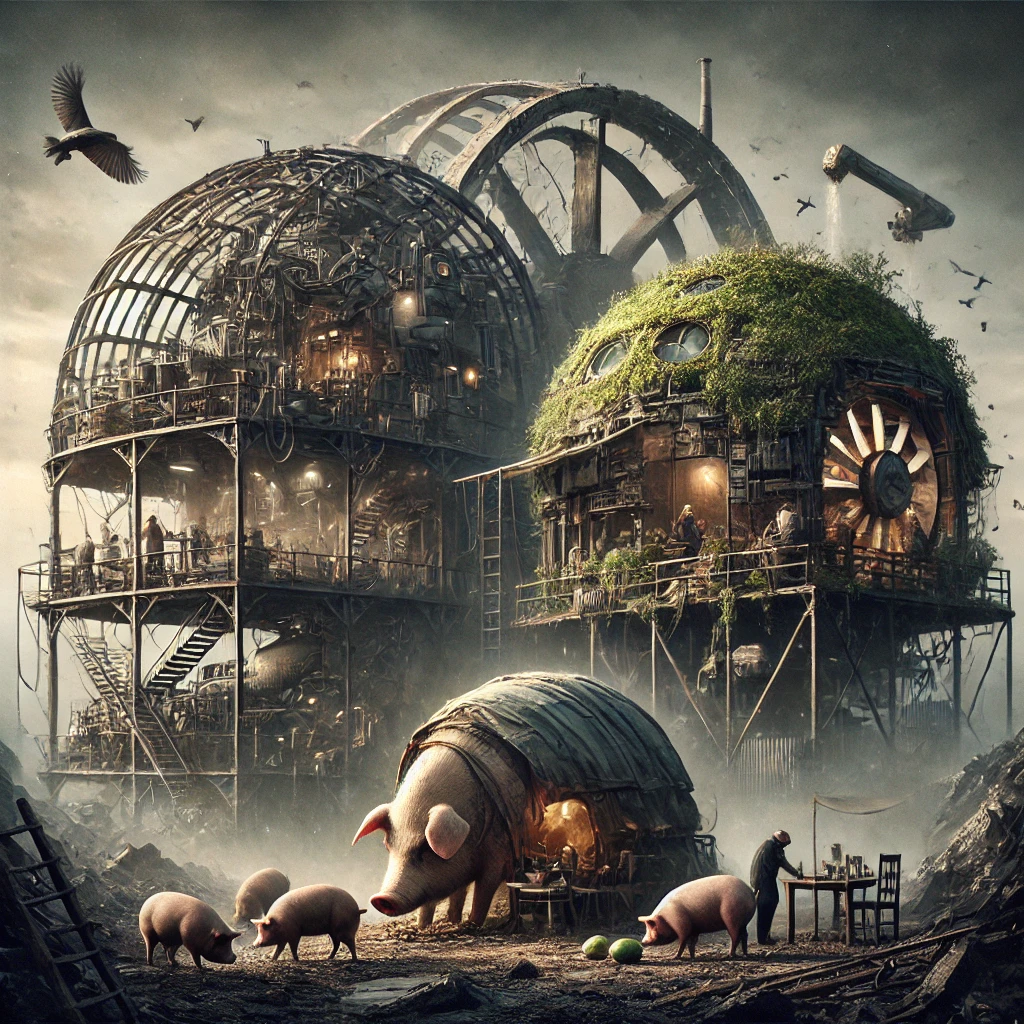
The Myth of the Last Shelter
AI GENERATION
The world was a graveyard of metal and dust. Once, it had been a thriving ecosystem—a place of green forests, blue skies, and quiet lakes. Now, all that remained were ruins. The air was thick with the acrid scent of burning plastic and oil, and the ground was cracked, barren, like a wound that refused to heal.
Three piglets—small and fragile in the face of this post-apocalyptic landscape—struggled to survive. Each had their vision of how life could continue in the ruins, each had their own idea of shelter, safety, and salvation. But the truth was simple: none of them were truly safe.
The first piglet, named Ironhoof, built his fortress of steel. Tall spires of metal rose like the bones of a giant, sharp and cold, stretching toward the gray sky. He filled his walls with machines—giant gears that turned without purpose, engines that roared in the silence, weapons that gleamed with dangerous promise. To Ironhoof, survival was about control, about the power of human-made structures, about making a world where nothing could touch him. But the walls of his fortress did not protect him from the constant hum of emptiness. As the wind howled outside, he sat alone in his sterile tower, staring at the screen that flickered in the dark. He wanted power, but it was the lack of meaning that gnawed at him.
The second piglet, Greenwhisk, crafted a dwelling of glass and plants. Her structure was a delicate blend of bio-tech and nature—vines curled around the frames, and bio-luminescent moss lit the pathways at night. She dreamt of a world where harmony with nature could return, where the earth could heal itself. The winds whispered through the leaves of trees that grew in the heart of her shelter, their roots entwined with the very wires that powered her home. Yet, Greenwhisk found no peace in the rustling of leaves. The gentle hum of life outside her walls was tainted by the constant reminder of the world’s decay. She wondered if she was merely hiding in a fragile illusion—a fragile dream that would wither when the last resource ran dry.
The third piglet, named Wildtail, had built his home in the ruins of nature itself. His shelter was less a building than an extension of the land—a cavernous space woven into the roots of an ancient tree, where branches reached down like veins connecting the past to the future. His philosophy was that true survival lay in returning to the land, in living as one with the forgotten world, in surrendering to the rhythms of the earth. Yet, as he lay in his shelter, he could hear the groans of the land itself, the cracking of the trees, the faint whispers of extinction in every gust of wind. How long could the earth withstand the weight of their need?
The world outside was constantly shifting—storms brewed and passed, but each one left its mark. The threats were always there—bandits who roamed the broken roads, scavengers who preyed on the weak, and the unrelenting erosion of the planet’s resources. But as each attack came, each threat loomed larger, the piglets began to see a different truth.
One evening, as the sun fell beneath a sky the color of ash, a violent storm raged over the land. Ironhoof’s fortress shook as the winds slammed against its steel walls. His machines buzzed erratically, flickering in and out of power. Greenwhisk’s plants withered under the pressure, their bioluminescent glow dimming, leaves curling in defeat. Wildtail’s tree was bent, its branches snapped like bones under the force of the storm.
The piglets emerged from their shelters and met in the middle of the ruined land. They had survived the storm, but the cost was clear. Ironhoof’s walls were battered and rusting. Greenwhisk’s glass cracked under the pressure. Wildtail’s roots had begun to decay.
“We are losing,” Ironhoof said, his voice hollow. “None of our shelters stand up to this world. We build, and it is destroyed. Over and over again.”
Greenwhisk, staring at the shattered remnants of her plants, spoke softly, “Perhaps we were never meant to fight against the world. Maybe we were meant to live with it. But even that… it’s slipping away.”
Wildtail, his eyes reflecting the dying light of the storm, whispered, “Maybe we’re not meant to survive at all. Maybe we’ve already lost.”
The three piglets stood in silence, facing the crumbling ruins of their shelters, and in that silence, they realized the true destruction was not in the storm, not in the broken world—but in themselves. They had built their shelters to protect against the world, but they had never stopped to question their own hearts, their own contradictions.
Ironhoof had sought power, but in the end, he was trapped within his own fortress of isolation. Greenwhisk had sought harmony with nature, but had she been blinded by her idealism, too fragile to withstand the world’s cruelty? Wildtail had sought surrender to the earth, but the earth was already dying, and with it, so was he.
They stood there, each lost in the ruins of their beliefs. The world was no longer something they could fight against—it was something that had already claimed them. The storm had passed, but the true storm—the one within them—raged on.
In the end, there was no answer. There was only the wind, the empty sky, and the sound of their hearts slowly breaking, one beat at a time.

I like this Ceremony of The Myth of the Last Shelter and piglets yell in my bones moving as if to catch me.
When You say “Greenwhisk found no peace in the rustling of leaves” i open myh mouth as if to suck up the etore dream of life.
We the living¡ Isn’t beautiful?
You have laugh me heartily.
Thanks Mykyta